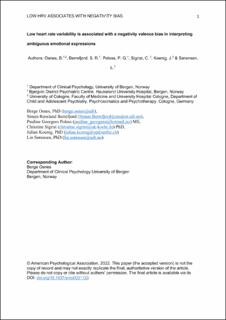| dc.description.abstract | Most people tend to overstate positive aspects of their experiences, that is, a positive valence bias. However, some people tend to have attenuated attention for negative aspects of perceived information, that is, negative valence bias. This dispositional tendency in either valence is especially significant for emotion regulation as it influences the intensity of later stages of emotional experiences. Heart rate variability (HRV) is used as an index of emotion regulation and for the effect dispositional valence bias has on social cognition. The aim of the current study was to investigate whether a positivity or negativity bias in processing ambiguous facial expressions would predict high or lower HRV, respectively, in a healthy sample. The Reading the Mind in the Eyes Test was presented to a sample of 128 healthy participants (N = 86 women participants), and resting HRV was acquired. In multiple linear regression analyses, the mean accuracy scores for items with positive, negative, and neutral valences were included as predictors of HRV. As a follow-up analysis, we tested whether a general tendency to interpret negative stimulus as positive, that is, a positivity bias, predicted HRV. Higher accuracy on items with negative emotional valence predicted lower HRV. There was no association between accuracy scores on items of positive or neutral valence and HRV. Higher positivity bias predicted higher HRV. The present findings suggest that a dispositional valence bias relates to levels of HRV and, as such, is influenced by the functioning of the vagal system. | en_US |
